ALY JAMES LAB Analog Or Digital Extended Models
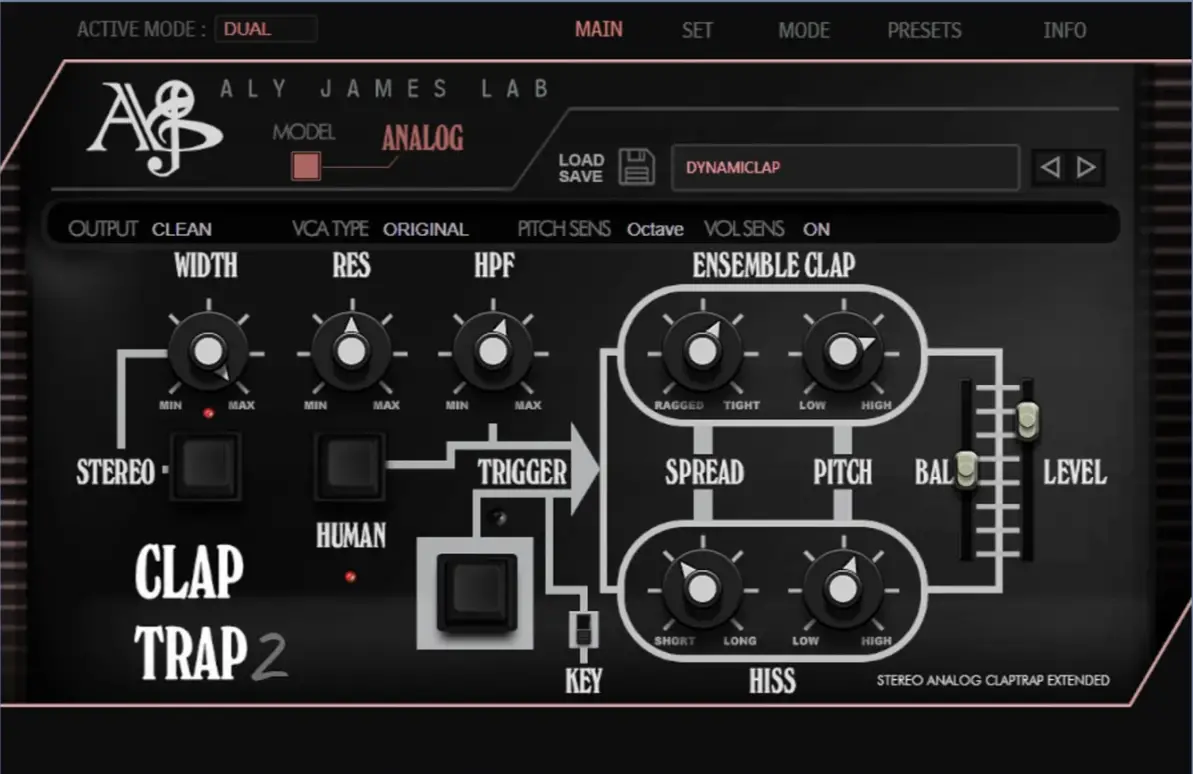
Product Information
Specifications
- Product Name: Claptrap Stereo Analog/Digital Claptrap Extended
- Manufacturer: Aly James Lab
- User Manual Version: 2.0
- Compatibility: 64-bit Host VST3, 64-bit host VST3 AU Universal 2 (Native Silicon/Intel)
Introduction
- The Claptrap is a versatile instrument designed to produce authentic ensemble handclaps, percussive crashes, and bursts of noise.
- It combines a digital recording of people clapping with white noise to create its characteristic sound.
- The instrument offers individual controls for the pitch and decay time of both clap and noise components, along with a humanizer function for added variability.
Features
- Authentic ensemble handclaps
- Percussive crashes and noise bursts
- Digital recording blending with white noise
- Variable sample rate technology for pitch control
- Analog noise generation with custom filter
- True stereo capabilities
- Extended ranges, fine tuning, and CV/MIDI response options
Installation
Ensure compatibility with 64-bit Host VST3 or 64-bit host VST3 AU Universal 2 (Native Silicon/Intel) for installation. Additional information can be found in the download link email or on the manufacturer’s website.
Product Usage Instructions
Main Panel
- The main panel includes controls specific to the Digital Claptrap MK3 and Analog Claptrap MK1/2 versions. Refer to the user manual for detailed information on each control’s functionality.
Output Modes
- The Claptrap can be used in SINGLE, DUAL, or MULTI OUT modes.
- Users can choose to utilize a specific model or a combination of both for varied sound generation. Adjust the settings accordingly based on the desired output mode.
Setting Parameters
- Each model (Digital Claptrap MK3 and Analog Claptrap MK1/2) has specific parameters that can be individually adjusted. Experiment with these parameters to achieve the desired sound characteristics.
Using the Humanizer Function
- The humanizer function adds a random, human feel to the output by selecting different parts of the digital recording each time the unit is triggered. Toggle the humanizer switch to incorporate this feature into your sound production.
INTRODUCTION
- The first Claptrap was analog, built approximately 1979/80, likely assembled by Dave Simmons himself, followed by the analog Simmons Claptrap (adding a humanizer function and a slightly different case) and completed in 1984 by the digital version: the Simmons Digital Claptrap, one of Simmons most important bread and butter products.
- The Clap Trap has been designed to produce authentic and repeatable ensemble handclaps at your command – it can produce other sounds such as percussive crashes and bursts of noise to give a long decay to snare drums.
- The instrument assembles its characteristic sound by controllably blending a digital recording of people clapping, stored in memory, with a general background crash of white noise.
- The recording is approximately 1.5 seconds long; however, both the clap and noise components of the sound have individual controls governing pitch and decay time.
- A switchable “humanizer” allows a different part of the digital recording to be outputted each time the unit is triggered, giving a random, human feel.
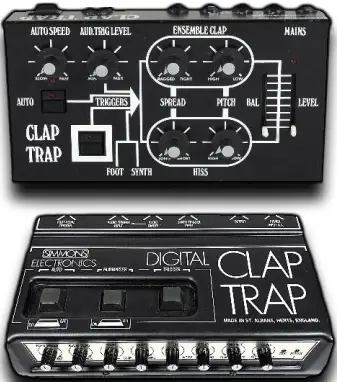
- In the MK3 version, the digital part is played using variable sample rate technology, which is used to change the pitch.
- This vintage technology produces additional harmonic content and contributes to the sound character we all love.
- In the MK1/2 version, claps were generated by a crazy mixture of oscillator modulations, modulated comparator-generated envelopes and other nasty things.
- The analog part in both models is a pitched noise, produced by filtering the noise source with a custom filter.
- I have made Claptrap 2.0 to be a one-on-one recreation in plug-in form. Thanks to reverse engineering my hardware unit, the digital source is bit accurate, the random technique (HUMANIZER) is perfectly replicated, and the virtual analog parts are modeled as closely as possible. In addition, I did some modifications like true stereo capabilities, extended ranges, fine tuning and CV/MIDI response options.
- For the first time available as a plug-in, version 2.0 now adds the full analog circuit of MK1. Claptrap gives you full control over the clap synth generation circuit.
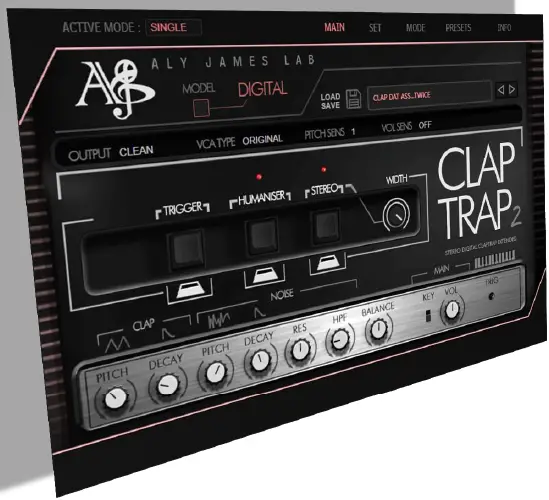
- Both units in Claptrap can be used in SINGLE, DUAL or MULTI OUT modes; you can then either use a specific model or a combination of both. (see output modes).
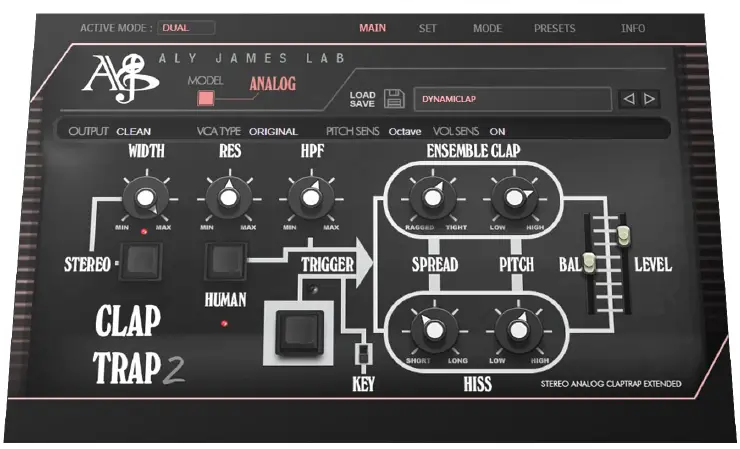
- Each model has specific parameters and can be set differently.
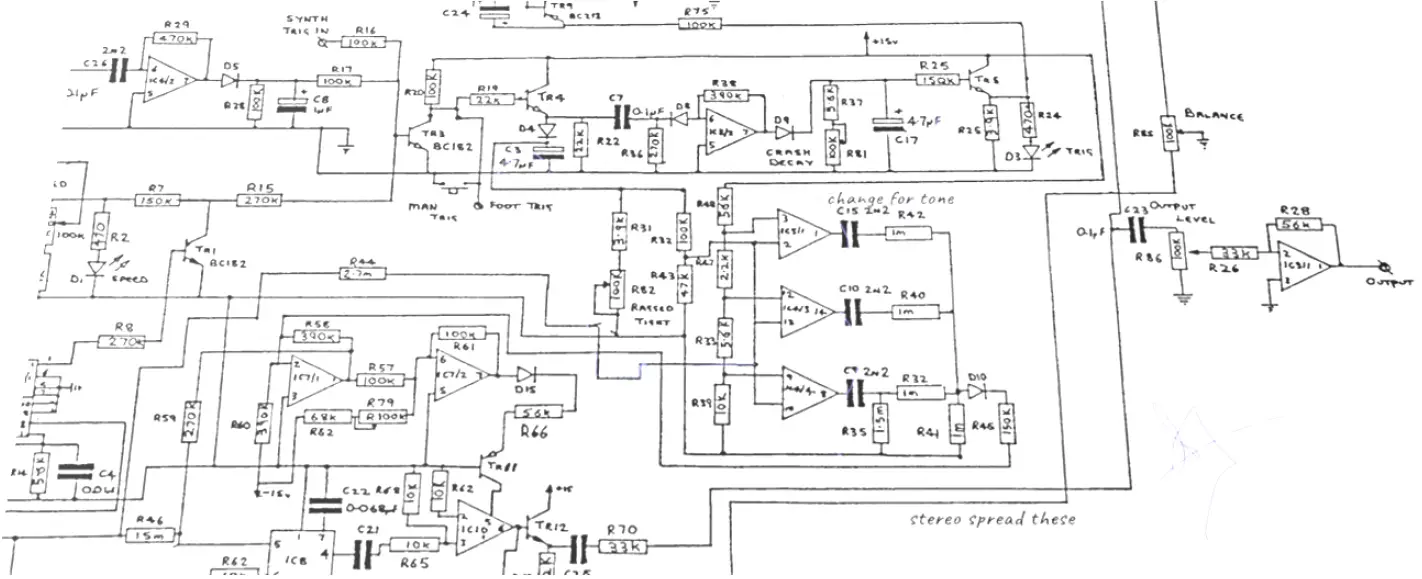
- This extended emulation is based on reverse engineering and old datasheets; it uses a C++ custom core with modeled analog circuitry.
Claptrap offers 2 trigger modes
- The default mode uses any incoming MIDI note to trigger the claptrap.
- Key mode when engaged uses MIDI note pitch as an offset to the currently set clap tuning, effectively tracking the pitch.
- Note that is an offset and not a “note frequency” tracking.
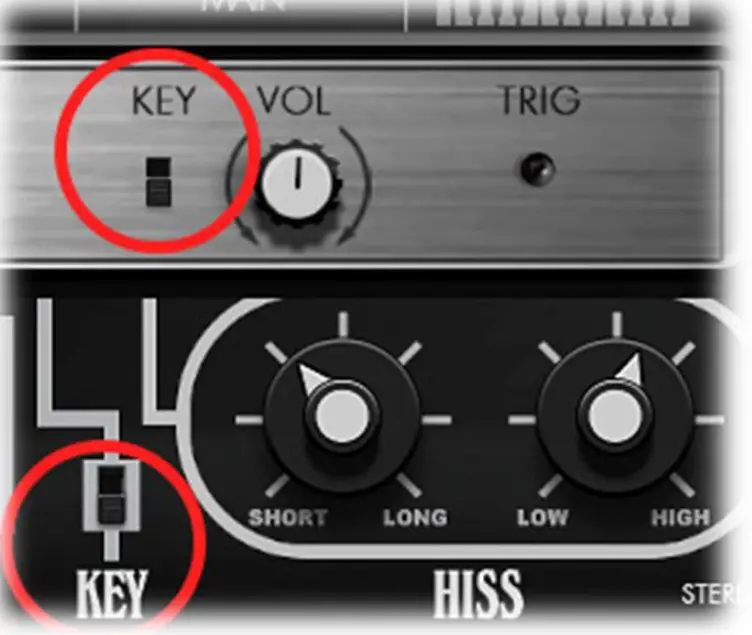
INSTALLATION
Compatibility
- Windows 10 +
- 64bit Host VST3
- Mac OS 10.10 +
- 64bit host VST3 AU
- Universal 2 (Native Silicon/Intel)
- Install Windows:
- Run Claptrap Installer
- Install Mac:
- Run Claptrap plug-in Installer
- Run Claptrap plug-in Presets Installer
- Additional installation info can be found in your “download link” Email and at the website.
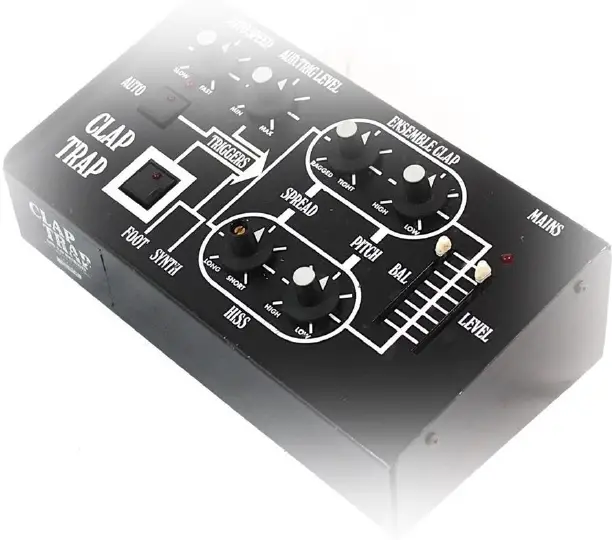
MAIN FEATURES
- Two circuit MODELS: Digital MK3 and the “freshly emulated” Analog MK1/2 model.
- Multi-output routing capability.
- Single or Dual operation.
- Settings and preset browser pages.
- Modelled SVF Noise Filter topology.
- Option to switch from original hardware noise SVF filter to a custom “fixed gain” peak filter.
- Digital Clap Tone EPROM swapping.
- Analog Clap Ensemble circuit bending: Pulses shape, Humanizer mod amount, reversed key-tracking…
- Trigger “thump” and Filter noise bleed emulation.
- Option to delay incoming trigger (max 100ms) on one unit.
- True stereo capability by running 2 modelled Claptrap internally or 4 in DUAL mode.
- Option to enable global circuit saturation (also reduces dynamic range).
- Most parameters respond to automation
CONTROL PANELS
- The Claptrap GUI interface is designed to be user-friendly and intuitive, organizing different parameters into separate sections/panels for easy access.

- MAIN: Main view area where you will control the selected Claptrap model.
- SET: Access global settings and model-specific settings area.
- MODE: Select between SINGLE, DUAL or MULTI OUT output modes.
- PRESETS: Internal presets browser.
- INFO: User Info, plug-In info and noise filter topology.
The main section displays the currently active output mode:
- Top left displays either single, dual or multi-out output mode.
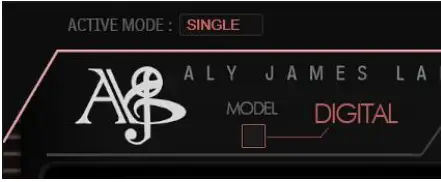
MAIN PANEL
- The main interface allows you to select the claptrap model you want to edit via the MODEL button.
- For each model, you will find the following basic controls and a TRIGGER button to quickly monitor a sound from the GUI (triggers at max velocity):
Digital Claptrap MK3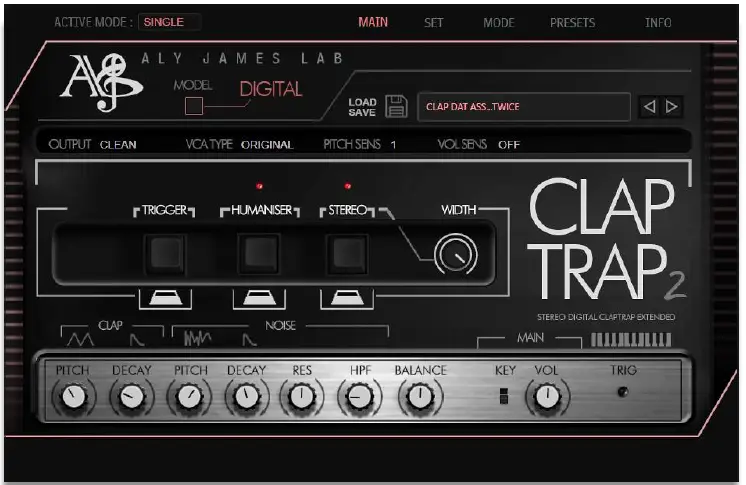
- The digital claptrap is composed of two main elements that can be controlled independently:
- A digital source stored into an EPROM chip is read at variable sample rate, the EPROM reading speed is defined by the pitch knob and the final output is shaped by a volume envelope which decay time is controlled by the decay knob.
- An analog noise generator filtered and “tuned” by a particular resonant SVF filter, the filter frequency is controlled by the pitch knob, it is further shaped by an envelope which decay is controlled by the decay knob.
- OUTPUT selector: Choose between CLEAN or ANALOG, clean is the pure signal without any extra bandwidth reduction whereas ANALOG simulates the high frequency loss for the original machine.
- VCA TYPE selector: Choose between the VCA original response (pretty linear) and EXP for an exponential response.
- PITCH SENS selector: The selected value defines how trigger velocity affects the sound’s pitch, a value of 0 turns the pitch velocity modulation CV off and OCTAVE is the highest possible setting, note that although it says “octave” the resulting 1V/Oct CV is further shaped and does not exactly end up being an exact octave jump in the circuit.
- VOLUME SENS selector: Choose between the ON or OFF; when ON, the trigger velocity will affect the final volume of the circuit; if OFF is selected, the volume is always equal to full velocity.
 TRIGGER button: This will manually trigger the claptrap from the GUI for quick and handy monitoring; the trigger is done at full velocity.
TRIGGER button: This will manually trigger the claptrap from the GUI for quick and handy monitoring; the trigger is done at full velocity. HUMANIZER button: The Humanizer is a key feature of Claptrap that ensures each digital clap sound is unique by constantly looping the EPROM counter. It is most effective at moderate to lower clap pitches; you may not hear the effect as clearly at higher pitches.
HUMANIZER button: The Humanizer is a key feature of Claptrap that ensures each digital clap sound is unique by constantly looping the EPROM counter. It is most effective at moderate to lower clap pitches; you may not hear the effect as clearly at higher pitches. STEREO button: Activates a second “cloned” claptrap circuit running in parallel; both cloned and current claptrap are panned hard L & R, producing a wider phase separation and stereo effect depending on the WIDTH.
STEREO button: Activates a second “cloned” claptrap circuit running in parallel; both cloned and current claptrap are panned hard L & R, producing a wider phase separation and stereo effect depending on the WIDTH. WIDTH knob: Working when STEREO is activated, the associated WIDTH knob offsets the EPROM clock and filter setting for the second cloned generator thus increasing the perceived stereo effect.
WIDTH knob: Working when STEREO is activated, the associated WIDTH knob offsets the EPROM clock and filter setting for the second cloned generator thus increasing the perceived stereo effect. CLAP PITCH knob: Controls the tuning or clock frequency for the digital EPROM, this is the sample rate of the digital part.
CLAP PITCH knob: Controls the tuning or clock frequency for the digital EPROM, this is the sample rate of the digital part. CLAP DECAY knob: Clap envelope’s decay.
CLAP DECAY knob: Clap envelope’s decay. NOISE PITCH knob: Controls the frequency of the tuning filter, the filter is special as its resonance peak will increase with pitch (see noise filter).
NOISE PITCH knob: Controls the frequency of the tuning filter, the filter is special as its resonance peak will increase with pitch (see noise filter).
- On the digital claptrap model, you can set (see settings) the noise filter to a custom designed variable bandwidth peak filter I used in Claptrap version 1.0.
 NOISE DECAY knob: Noise envelope’s decay.
NOISE DECAY knob: Noise envelope’s decay. HPF knob: Output’s high pass filter frequency.
HPF knob: Output’s high pass filter frequency. BALANCE Knob: Balance between the Clap and the Noise part.
BALANCE Knob: Balance between the Clap and the Noise part. KEY selector: activates keyboard pitch tracking.
KEY selector: activates keyboard pitch tracking. VOL knob: Digital Claptrap MK3 main volume.
VOL knob: Digital Claptrap MK3 main volume.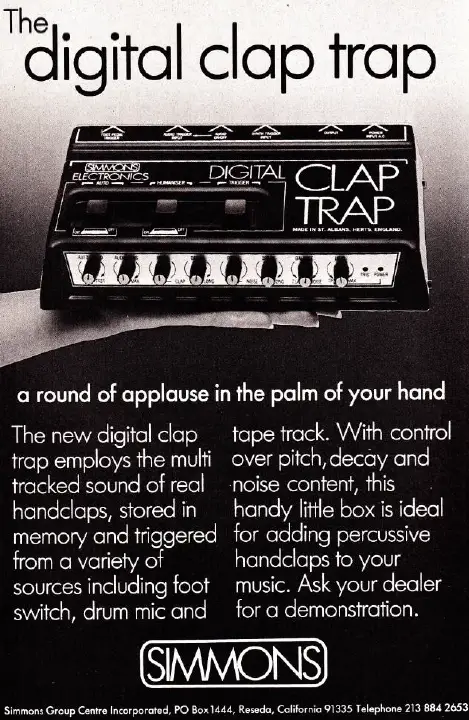
Analog Claptrap MK1/2
- The analog claptrap is composed of two main elements that can be controlled independently:
- An analog clap source made out of an analog oscillator, frequency modulated so fast by unequally spaced pulses envelope and sine generator to produce synthesized claps, those modulated analog comparators generated envelopes will be affected by the SPREAD, PITCH, HUMANIZER knobs and also by internal settings like: ensemble pulse shape, humanizer mod amount or mod LFO speed.
- These internal settings can generate a more or less “tonal sound, a particularity you can also find on real hardware MK1/2 claptraps depending on their internal settings or electronic parts condition.
- Overall, this clap synth design can get nasty pretty quick and can produce some weird noises while also being capable of emulating very usable claps.
- An analog noise generator filtered and “tuned” by a particular resonant SVF filter, the filter frequency is controlled by the pitch knob, it is further shaped by an envelope which decay is controlled by the SPREAD knob.
- OUTPUT selector: Choose between CLEAN or ANALOG, clean is the pure signal without any extra bandwidth reduction whereas ANALOG simulates the high frequency loss for the original machine.
- VCA TYPE selector: Choose between the VCA original response (pretty linear) and EXP for an exponential response.
- PITCH SENS selector: The selected value defines how trigger velocity affects the sound’s pitch, a value of 0 turns the pitch velocity modulation CV off and OCTAVE is the highest possible setting, note that although it says “octave” the resulting 1V/Oct CV is further shaped and does not exactly end up being an exact octave jump in the circuit.
- VOLUME SENS selector: Choose between the ON or OFF; when ON, the trigger velocity will affect the final volume of the circuit; if OFF is selected, the volume is always equal to full velocity.
 TRIGGER button: This will manually trigger the claptrap from the GUI for quick and handy monitoring; the trigger is done at full velocity.
TRIGGER button: This will manually trigger the claptrap from the GUI for quick and handy monitoring; the trigger is done at full velocity. HUMANIZER button: The Humanizer in the analog version introduces extra modulation, how much precisely can be set from the SET panel control named Humanizer Modulation Amount and its associated Mod LFO Speed.
HUMANIZER button: The Humanizer in the analog version introduces extra modulation, how much precisely can be set from the SET panel control named Humanizer Modulation Amount and its associated Mod LFO Speed. STEREO button: permits the panoramic spreading of the discrete analog clap envelopes panned left, right and center while also cloning the 2nd filter. This will produce a stereo effect depending on the WIDTH.
STEREO button: permits the panoramic spreading of the discrete analog clap envelopes panned left, right and center while also cloning the 2nd filter. This will produce a stereo effect depending on the WIDTH. WIDTH knob: Working when STEREO is activated, the associated WIDTH knob increases the stereo width.
WIDTH knob: Working when STEREO is activated, the associated WIDTH knob increases the stereo width. ENSEMBLE CLAP PITCH knob: Controls the tuning of the analog modulated oscillator effectively producing low to high pitched “claps”.
ENSEMBLE CLAP PITCH knob: Controls the tuning of the analog modulated oscillator effectively producing low to high pitched “claps”. ENSEMBLE CLAP SPREAD knob: Clap envelope’s decay, labelled ragged to tight for slow to fast, the decay internally acts on the comparators reference signal.
ENSEMBLE CLAP SPREAD knob: Clap envelope’s decay, labelled ragged to tight for slow to fast, the decay internally acts on the comparators reference signal. HISS PITCH knob: Controls the frequency of the noise (here labeled “hiss”) tuning filter, the filter is special as its resonance peak will increase with pitch (see noise filter).
HISS PITCH knob: Controls the frequency of the noise (here labeled “hiss”) tuning filter, the filter is special as its resonance peak will increase with pitch (see noise filter). HISS SPREAD knob: Noise envelope’s decay.
HISS SPREAD knob: Noise envelope’s decay. HPF knob: Output’s high pass filter frequency.
HPF knob: Output’s high pass filter frequency.- BALANCE lever: Balance the Clap and the Noise parts.
- KEY selector: activates keyboard pitch tracking.
- VOL lever: Analog Claptrap MK1/2 main volume.
SET PANEL
The settings panel, full control over the internal circuit. 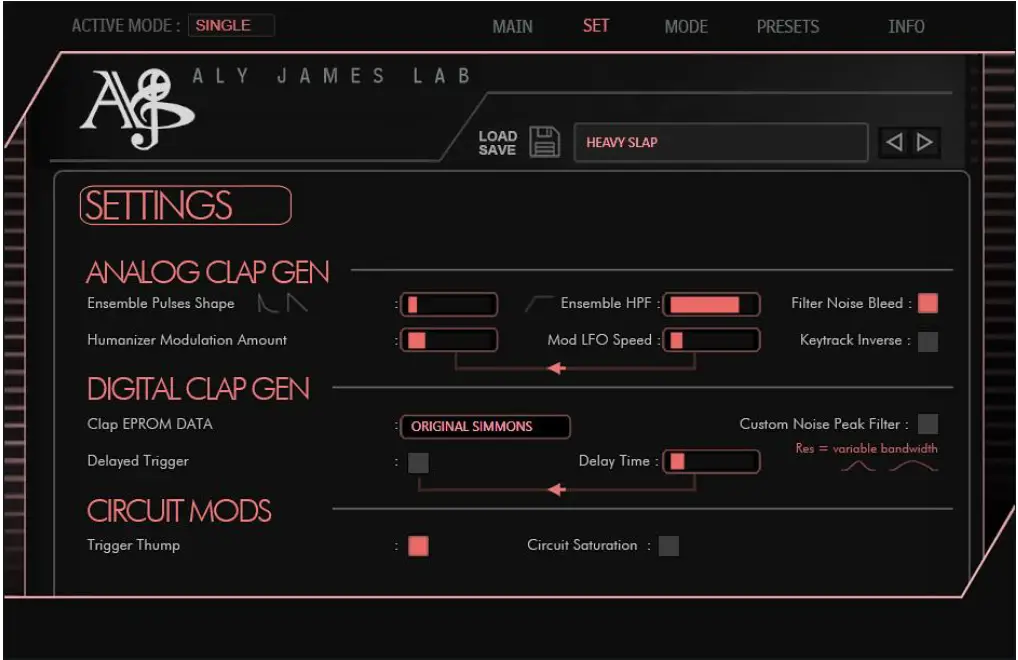
ANALOG CLAP GEN
 Ensemble Pulses Shape: Adjusts the ensemble claps generation circuit by changing internal capacitors; a low value gives atonal short pulses while a higher value will make the tone of the internal oscillator more audible while using longer pulse length.
Ensemble Pulses Shape: Adjusts the ensemble claps generation circuit by changing internal capacitors; a low value gives atonal short pulses while a higher value will make the tone of the internal oscillator more audible while using longer pulse length.- It is a crucial setting for analog claps, depending on what type of sound you are after.
- If you listen to some real vintage analog claptrap in person or in online videos, you might hear some differences between units, and this setting right here is often the reason why.
 Humanizer Modulation Amount: When Humanizer is ON, this setting controls the amount of modulation used in the circuit, a shaped sine wave LFO is internally responsible for the clever modulation, a low value will produce a decent number of “random” claps while the highest values will artificially increase the number of perceived claps.
Humanizer Modulation Amount: When Humanizer is ON, this setting controls the amount of modulation used in the circuit, a shaped sine wave LFO is internally responsible for the clever modulation, a low value will produce a decent number of “random” claps while the highest values will artificially increase the number of perceived claps. 
- Not modulated ensemble clap output.

- Modulated (Humanizer) ensemble clap output.
 Mod LFO Speed: When Humanizer is ON, this setting controls the speed (frequency) of the main sine LFO modulator. This goes hand in hand with the Humanizer Modulation Amount.
Mod LFO Speed: When Humanizer is ON, this setting controls the speed (frequency) of the main sine LFO modulator. This goes hand in hand with the Humanizer Modulation Amount. Ensemble HPF: This controls the frequency of the ensemble clap output filter. The filter is a simple high-pass filter, you can set it to taste for let more or less bass frequency pass-through.
Ensemble HPF: This controls the frequency of the ensemble clap output filter. The filter is a simple high-pass filter, you can set it to taste for let more or less bass frequency pass-through. Filter Noise Bleed: If activated, a portion of direct unfiltered noise passes through the noise filter.
Filter Noise Bleed: If activated, a portion of direct unfiltered noise passes through the noise filter. Key-track Inverse: Inverse the key tracking (if KEY mode is ON). This can be interesting when working in DUAL mode; the analog claptrap would have an inverted key-track while the digital would not, and going up on the keys would increase the pitch of one and decrease the other.
Key-track Inverse: Inverse the key tracking (if KEY mode is ON). This can be interesting when working in DUAL mode; the analog claptrap would have an inverted key-track while the digital would not, and going up on the keys would increase the pitch of one and decrease the other.
DIGITAL CLAP GEN
 Clap EPROM DATA: The digital claptrap used a variable sample-rate controlled EPROM to store its body clap sound. Claptrap 2 offers the original Simmons sound and a selection of custom sounds to choose from.
Clap EPROM DATA: The digital claptrap used a variable sample-rate controlled EPROM to store its body clap sound. Claptrap 2 offers the original Simmons sound and a selection of custom sounds to choose from.- This is a useful feature, notably in DUAL mode, where the digital clap could be used as a second layered drum. Note that the humanizer function will be deactivated unless you select “ORIGINAL SIMMONS”.
 Delayed Trigger: Activates a short delay on the incoming trigger, useful in DUAL mode to slightly delay one clap from the other.
Delayed Trigger: Activates a short delay on the incoming trigger, useful in DUAL mode to slightly delay one clap from the other. Delay Time: Sets the actual delay time applied to the trigger delay (if activated).
Delay Time: Sets the actual delay time applied to the trigger delay (if activated). Custom Noise Peak Filter: Uses a custom peak filter designed in Claptrap initial version 1.0 (see noise filter).
Custom Noise Peak Filter: Uses a custom peak filter designed in Claptrap initial version 1.0 (see noise filter).
CIRCUIT MODS
 Trigger Thump: When this recreates the trigger pulse bleed on the output, effectively creating a short thump/click sound at the beginning of the sound, this is part of the charm.
Trigger Thump: When this recreates the trigger pulse bleed on the output, effectively creating a short thump/click sound at the beginning of the sound, this is part of the charm.
- If you struggle to hear what it does and think this is snake oil, just drop the volume to the minimum and listen.
 Circuit Saturation: Engage soft analog saturation on the output stage, reducing dynamics.
Circuit Saturation: Engage soft analog saturation on the output stage, reducing dynamics.
OUTPUT MODE PANEL
- Claptrap 2 benefits from having two models in one; you can either use them separately or in various combo modes.
- We will call the digital clap unit D-CLAP and the analog clap A-CLAP; when neither is specified, we will simply use CLAP
- SINGLE MODE: Only one unit is used, which is useful when you just need one steady clap module.

- DUAL MODE: Both units are used and mixed, great for a richer clap sound or layering. When in dual mode, you can use the digital clap with a delayed trigger and/or with a different clap body sound.

- MULTI OUT MODE: Both units are used, and each one has a specific stereo output channel, typically used when you need to mix both parts differently in your DAW.

PRESET BROWSER PANEL
- The preset browser is a convenient way to select presets.
- At the top of the GUI, you can find a LOAD/SAVE disk icon from where you can load or save individual presets or banks in either. vstpreset (VST3). aupreset (AU) or plain text .xml.
- For banks, the xml format is the preferred one.
NOISE FILTER
ORIGINAL FILTER DESIGN
- The VCF in the claptrap was a state-variable bi-quad bandpass filter designed to “tune” the noise generator.
- Its integrator configuration makes the set resonance increase with filter frequency.
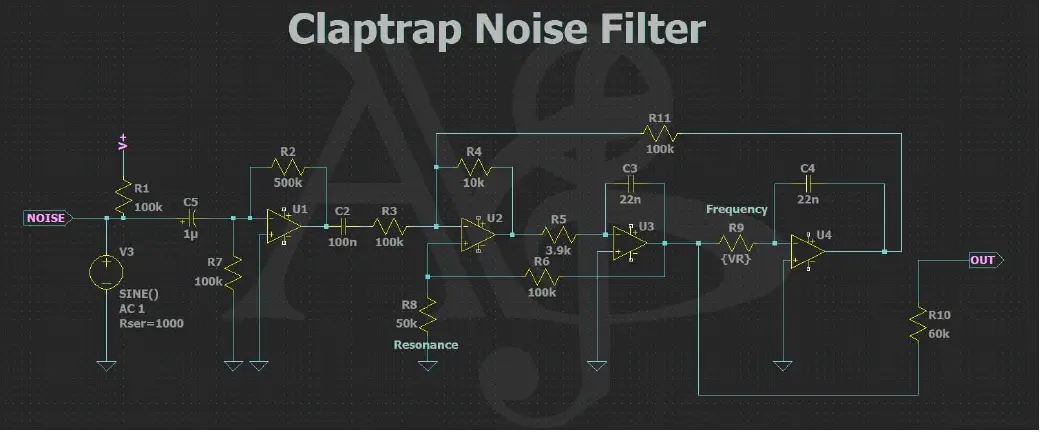
- Claptrap 2 models this filter, giving you control over the noise filter pitch (like the original units) and its internal (originally a trimmer) resonance.
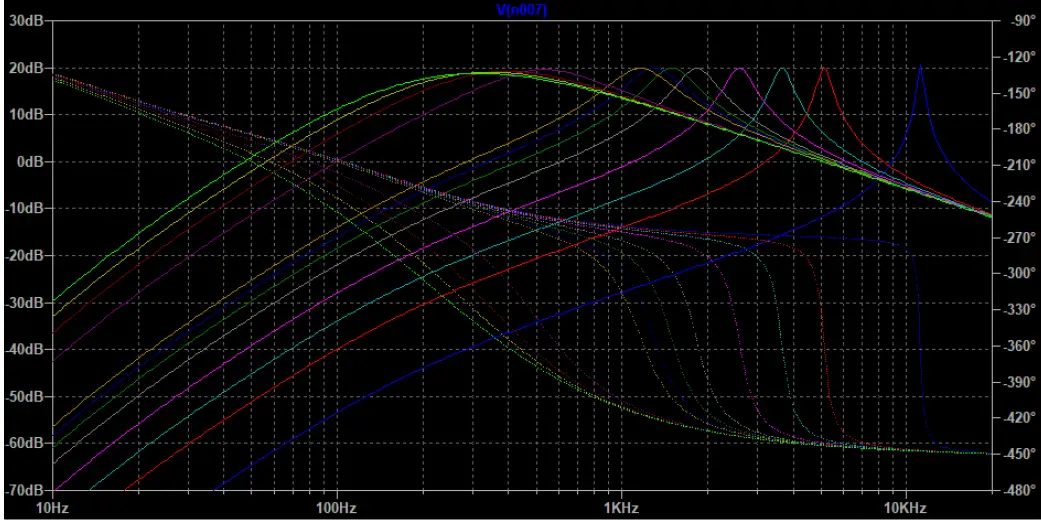
- Figure 1 SVF Filter response plot
CUSTOM PEAK FILTER
- In the first version of my claptrap plug-in which only modeled the digital MK3 unit, I opted for a custom-designed peak filter instead of sticking 100% to the original filter, you can now choose between original or custom in version 2.
- The custom filter produces a more aggressive noise and contains more unfiltered high frequencies.
- You can try both and choose what sounds best for your application.
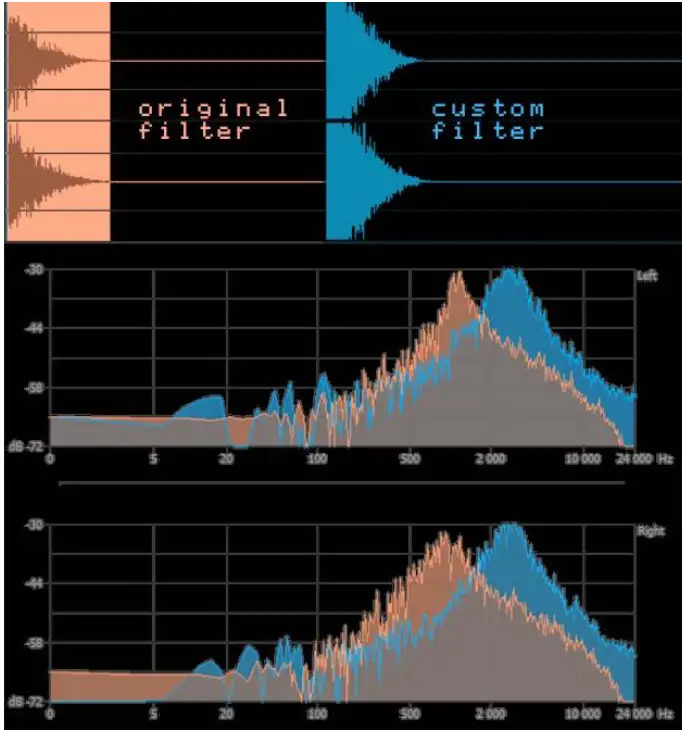
- Figure 2 filters response at similar settings
PRESETS IMPORT / EXPORT
- VST3, XML, AU preset.
- Claptrap 2 can load and import its own presets & banks.
- Most parameters and all MIDI LEARNED & ASSIGNED parameters will be saved per patch.
- At the top of the GUI, you will find a LOAD/SAVE disk icon from where you can load or save individual presets or banks in either. vstpreset (VST3). aupreset (AU) or plain text .xml.
- For banks, the xml format is the preferred one.
MIDI AUTOMATION
- Almost all Claptrap parameters can be automated via MIDI learn or DAW automation.
- Simply right click on a button, knob or slider to assign external MIDI Control or use DAW automation.
- Almost all types of MIDI messages can be assigned or MIDI learned.
- Right-click unlearn to get rid of the learned assignation.
LINKS
- Official Website https://www.alyjameslab.com/
- HOPE YOU HAVE FUN WITH THE CLAPTRAP!
DISCLAIMER
- CLAPTRAP (the software) is provided as-is, without warranty of any kind. Aly James Lab (the Author) disclaim all warranties relating to the Software, whether express or implied, including but not limited to any implied warranties of merchantability and fitness for a particular purpose, and all such warranties are expressly and specifically disclaimed.
The Author shall not be liable for any indirect, consequential or incidental damages arising out of the use or inability to use the Software, even if the Author has been advised of the possibility of such damages or claims. - The user of the Software bears all risk as to the quality and performance of the Software. If your computer blows up, I say, “I wasn’t there!” Of course, that should not happen…
- All manufacturer and product names mentioned on this page are trademarks of their respective owners, which are in no way associated or affiliated with ALYJAMESLAB.
- The trademarks of other manufacturers are used solely to identify the products of those manufacturers whose tones and sounds were studied during ALYJAMESLAB sound development.
- All names of instruments and inventors have been included for illustrative and educational purposes only and do not suggest any affiliation or endorsement of CLAPTRAP by any company or instrument inventor.
- alyjameslab.com
FAQ
- Q: Can I use Claptrap with a 32-bit host?
- A: No, Claptrap is compatible with 64-bit Host VST3 or 64-bit host VST3 AU Universal 2 (Native Silicon/Intel) only.
- Q: How do I access the extended ranges and fine-tuning options?
- A: The extended ranges and fine-tuning options can be accessed through the respective controls on the interface. Refer to the user manual for detailed instructions on utilizing these features.
Documents / Resources
 |
ALY JAMES LAB Analog Or Digital Extended Models [pdf] User Manual Digital Claptrap MK3, Analog Claptrap MK1, Analog Claptrap MK2, Analog Or Digital Extended Models, Digital Extended Models, Extended Models |
